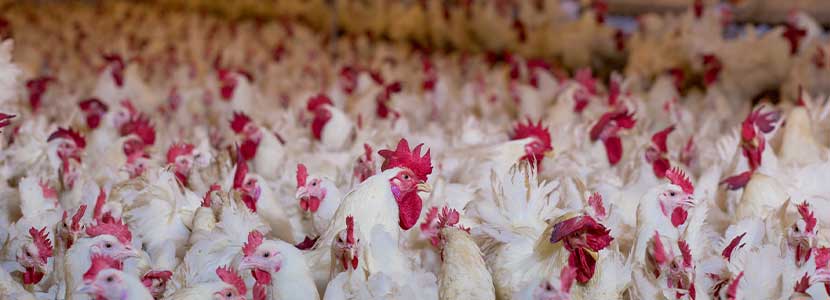 29 Jun 2022
29 Jun 2022
Broiler production without the use of in-feed preventive antibiotics, has made gut health syndromes, diseases and associated performance losses rather common within the poultry industry. This has challenged producers and veterinarians to find solutions for maintaining production levels without the use of Antibiotic Growth Promoters (AGPS).
Introduction
Chicken meat has become one of the most sustainable types of animal protein in terms of production efficiency and profitability in the last decades. This has to do with the fact that broiler production requires less feed consumption per kilogram of produced meat while also requiring less land and water for both farming and feed production.
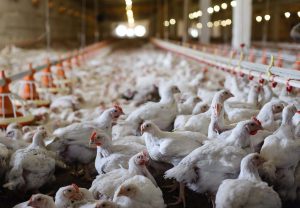 Broiler farm
Broiler farm
Broiler production has experienced significant improvements in animal performance parameters such as genetic selection for high-performing chicken lines, technological developments in hatching and housing conditions, and feed optimization and management practices that support (intestinal) health. Such improvements are reflected in an ever decreasing feed conversion (kg feed consumed per kg body weight) and reduced time to achieve market body weight (Zuidhof et al., 2014). Achieving high efficiency levels and increased yields, which have made this type of production even more attractive.
![]() Broiler weight gain evolution over the past decades
Broiler weight gain evolution over the past decades
The use of antimicrobial growth promoters(AGPs) is a practice that has been banned in many countries worldwide. On the other hand despite a gradual decrease, the use of therapeutic antimicrobials in the animal production industries is still considerably high. This has led to a scenario in which animals and their microbiota are experiencing significant changes. Considering the fact that animal breeds have been used for over 50 years almost exclusively within production systems where antimicrobial use was a common practice.
AGP bans and the imperative need to modify production systems
New challenges in broiler production 
Reductions or complete bans on antimicrobial use have resulted in the onset of diseases and syndromes that were previously overlooked or had low prevalence levels. Most of these syndromes are of intestinal origin and are associated with intestinal disturbances. Therefore, approximately 60% of therapeutic antibiotic use in broilers is related to intestinal disease control.
The necessary move away from antimicrobials has generated increasing concerns in regards to gut health. Bacterial diseases, enteritis, dysbiosis, and poor digestibility have become major culprits. These entities share a common denominator, in the form of microbial shifts associated with increased epithelial permeability and inflammation. Resulting in performance reductions, that are commonly related to nutrient excesses and feed-derived issues (nutrients with poor digestibility, excess protein and/or energy levels).
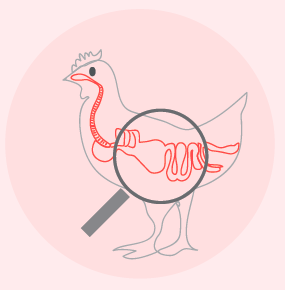
Common broiler intestinal diseases and syndromes
While it is easy to diagnose diseases such as coccidiosis and clinical necrotic enteritis, more subtle gut health disorders affecting animal performance are more complicated to diagnose.
A syndrome that has emerged simultaneously with the ban on growth promoting antibiotics is what ios known as ‘dysbacteriosis’. It is a poorly described condition which can sometimes be associated with conditions such as: ‘wet litter’, ‘non-specific bacterial enteritis’, ‘small intestinal bacterial overgrowth’, ‘malabsorption’. However such correlation is not always evident.
The common clinical signs for this condition are: thinning and ballooning of the small intestine, increased faecal water content and reduced digestibility of feed with evident undigested residues in the faeces (Teirlynck et al., 2011; Ducatelle et al., 2015). In many cases, this syndrome can be linked to increases in feed conversion rates, reduced body weight and an overall diminished performance.
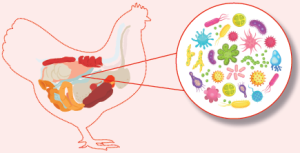 Impacts of “dysbiosis” on gut health
Impacts of “dysbiosis” on gut health
It is generally suggested that ‘dysbacteriosis’ or “dysbiosis” is a condition where interactions between gut microbiota and the host are impaired to an extent in which gut health becomes suboptimal. All this is probably influenced by nutrition and it is suggested that the altered composition of the gut microbiota induces changes in the gut wall, including morphological changes (villus length decreases, crypt depth increases, epithelial cell damage) and inflammatory reactions (infiltration of immune cells in the wall). The combination of a suboptimal microbiota combined with effects on the gut wall would then most likely interfere with digestive processes, eventually leading to poor performance, and induce enteritis.
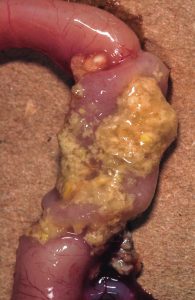
Necrotic Enteritis
Necrotic enteritis is probably the most severe example of a disease that has emerged after the ban on antibiotic growth promoter use in broiler feed. This condition has caused a significant economic burden on the poultry industry at a global scale (Skinner et al., 2010; Kaldhusdal et al., 2016). This disease is typically associated with nutritional excesses within the gut as well as predisposing epithelial defects caused by mycotoxins and coccidia. It has a greater prevalence amongst animals with high body weight gains, which underscores its direct correlation with production parameters (Moore, 2016; own unpublished data).
Forms of Necrotic Enteritis
This type of enteritis can occur as an acute clinical form which is characterized by a sudden increase in mortality, and as a subclinical form which results in a lower weight at slaughter age. Macroscopic necrotic lesions are found in the mucosa of the small intestine upon necropsy, which reveals a clear compromise of the intestinal barrier as well as severe mucosal inflammation (Prescott et al., 2016). Such lesions can be found in both types of presentations whether it is the clinical or subclinical form.
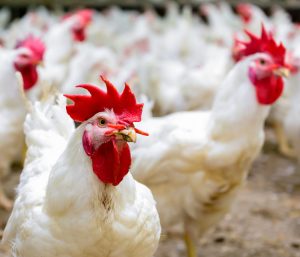
This entry will be continued with a complimentary publication….
Subscribe now to the technical magazine of animal nutrition
AUTHORS

Nutritional Interventions to Improve Fertility in Male Broiler Breeders
Edgar Oviedo
The Use of Organic Acids in Poultry: A Natural Path to Health and Productivity
M. Naeem
Synergistic Benefits of Prebiotics and Probiotics in Poultry, Swine, and Cattle
Gustavo Adolfo Quintana-Ospina
Hybrid Rye Potential in Laying Hen Feed Rations
Gwendolyn Jones
A day in the life of phosphorus in pigs: Part I
Rafael Duran Giménez-Rico
Use of enzymes in diets for ruminants
Braulio de la Calle Campos
Minerals and Hoof Health in the Pregnant Sow
Juan Gabriel Espino
Impact of Oxidized Fats on Swine Reproduction and Offspring
Maria Alejandra Perez Alvarado